Service and Management Strategies Report for Broughton House
VerifiedAdded on 2021/04/21
|24
|5752
|122
Report
AI Summary
This report presents a service design proposal for Broughton House, a boutique hotel, addressing its entire service spectrum. It emphasizes the management of service quality within the hotel industry and strategies for improving service failure recovery, using the SERVQUAL model to enhance customer satisfaction and minimize service failures. The analysis covers Broughton House's service concept, strategies for managing service encounters, service quality, service processes, failure and recovery, and customer relationships. It also examines the experience factor in service design and delivery, offering recommendations to improve service quality, customer satisfaction, and overall brand image. The report suggests strategies like comment cards and employee feedback programs to gather insights and improve service delivery, aiming for long-term success in the competitive hospitality market.
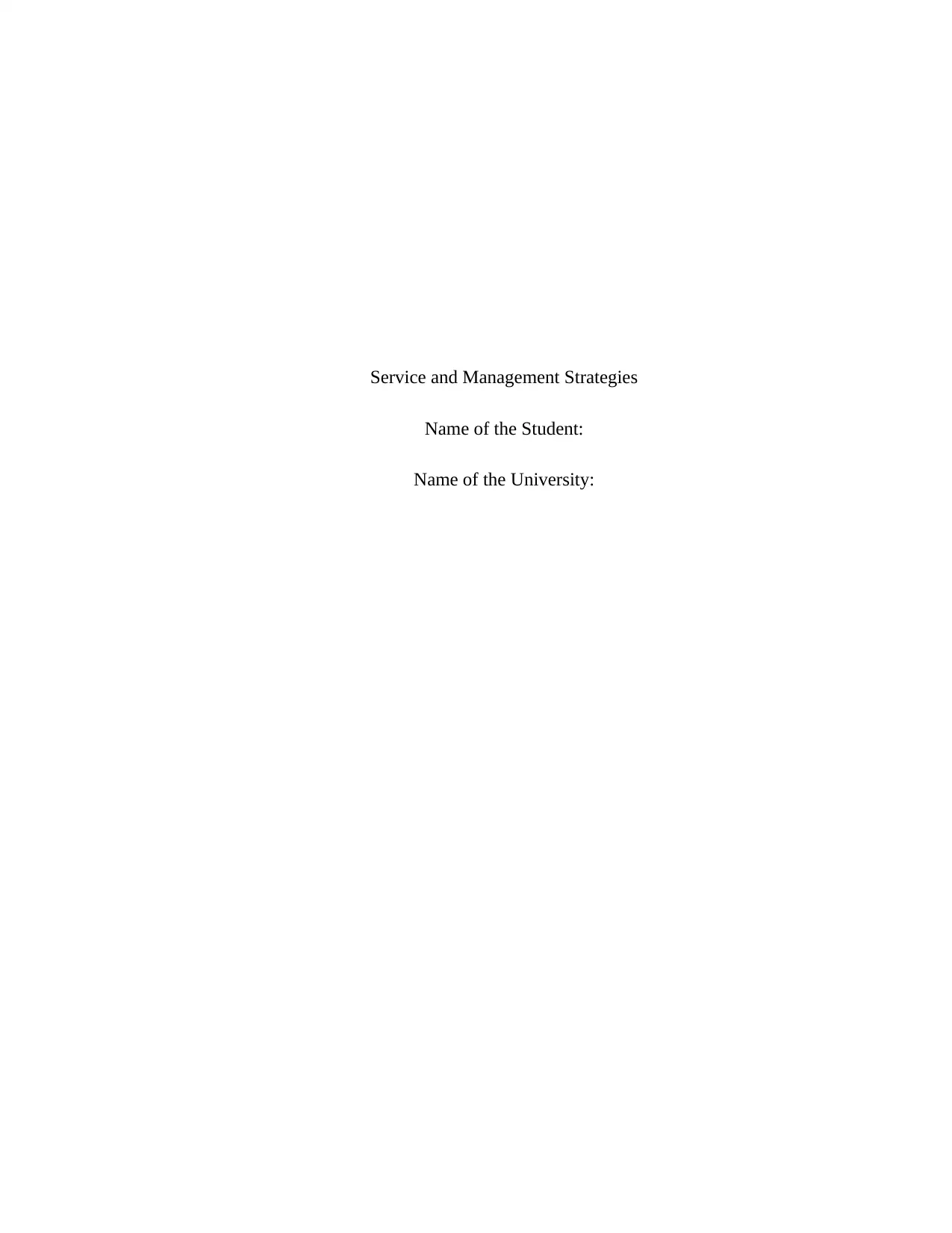
Service and Management Strategies
Name of the Student:
Name of the University:
Name of the Student:
Name of the University:
Paraphrase This Document
Need a fresh take? Get an instant paraphrase of this document with our AI Paraphraser
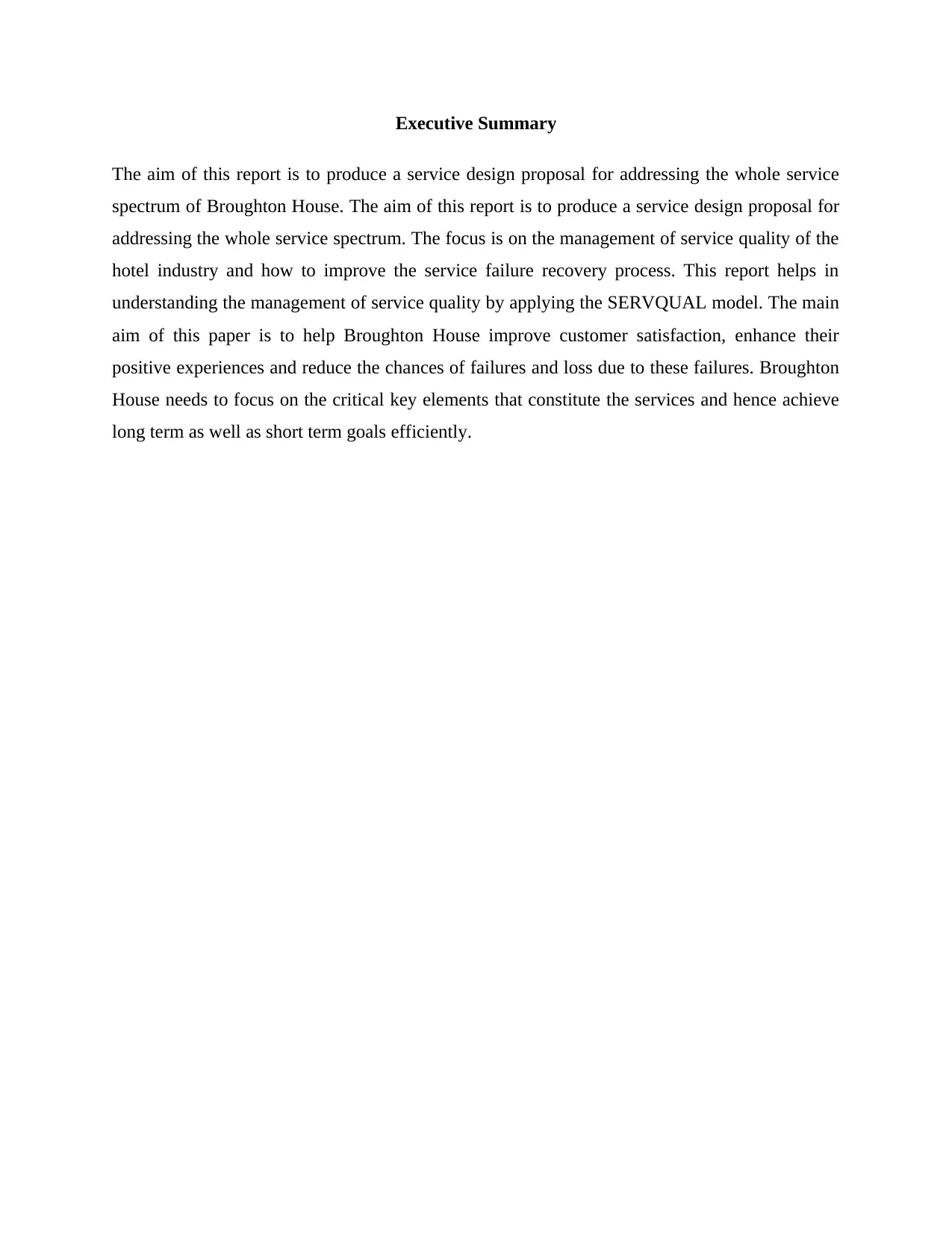
Executive Summary
The aim of this report is to produce a service design proposal for addressing the whole service
spectrum of Broughton House. The aim of this report is to produce a service design proposal for
addressing the whole service spectrum. The focus is on the management of service quality of the
hotel industry and how to improve the service failure recovery process. This report helps in
understanding the management of service quality by applying the SERVQUAL model. The main
aim of this paper is to help Broughton House improve customer satisfaction, enhance their
positive experiences and reduce the chances of failures and loss due to these failures. Broughton
House needs to focus on the critical key elements that constitute the services and hence achieve
long term as well as short term goals efficiently.
The aim of this report is to produce a service design proposal for addressing the whole service
spectrum of Broughton House. The aim of this report is to produce a service design proposal for
addressing the whole service spectrum. The focus is on the management of service quality of the
hotel industry and how to improve the service failure recovery process. This report helps in
understanding the management of service quality by applying the SERVQUAL model. The main
aim of this paper is to help Broughton House improve customer satisfaction, enhance their
positive experiences and reduce the chances of failures and loss due to these failures. Broughton
House needs to focus on the critical key elements that constitute the services and hence achieve
long term as well as short term goals efficiently.
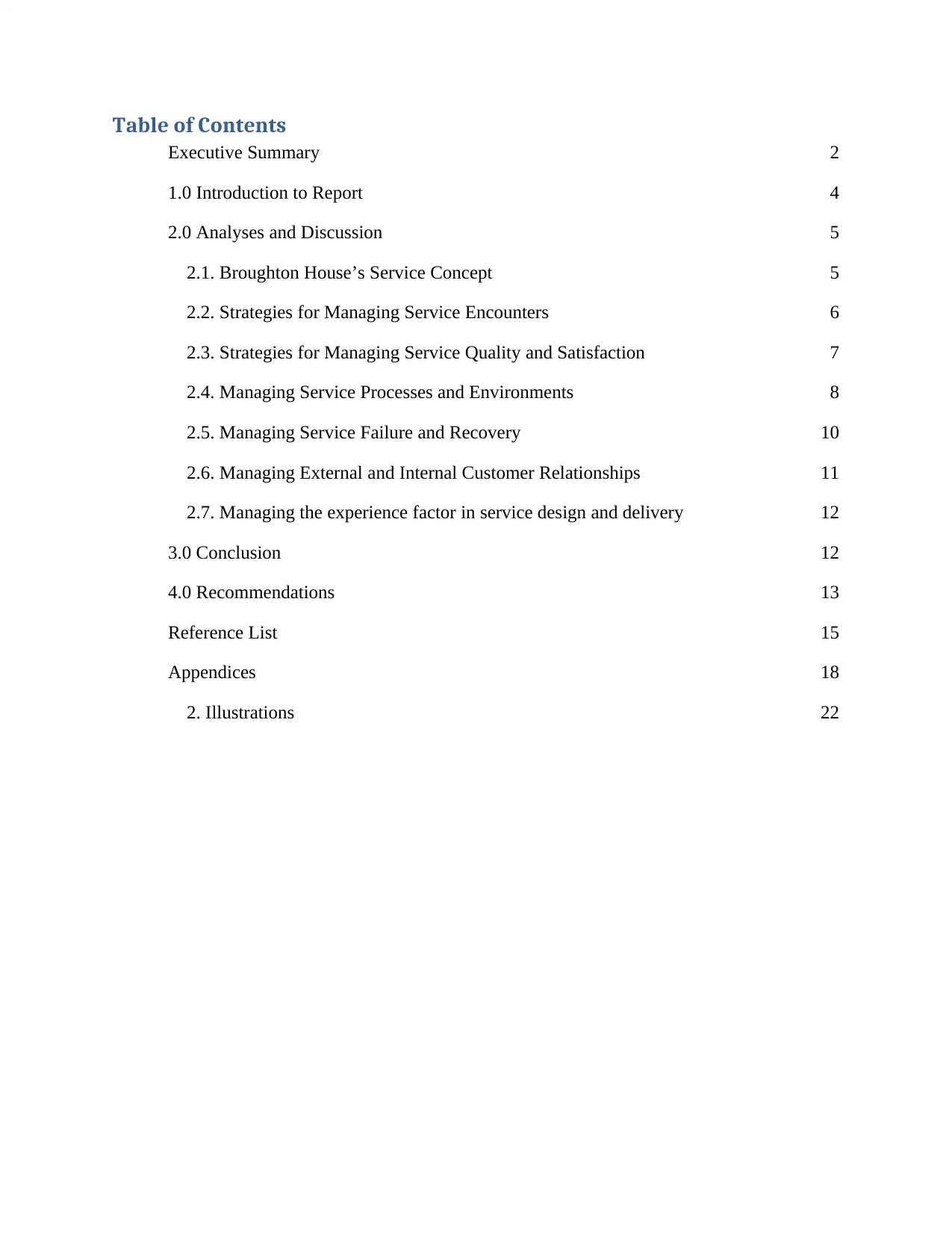
Table of Contents
Executive Summary 2
1.0 Introduction to Report 4
2.0 Analyses and Discussion 5
2.1. Broughton House’s Service Concept 5
2.2. Strategies for Managing Service Encounters 6
2.3. Strategies for Managing Service Quality and Satisfaction 7
2.4. Managing Service Processes and Environments 8
2.5. Managing Service Failure and Recovery 10
2.6. Managing External and Internal Customer Relationships 11
2.7. Managing the experience factor in service design and delivery 12
3.0 Conclusion 12
4.0 Recommendations 13
Reference List 15
Appendices 18
2. Illustrations 22
Executive Summary 2
1.0 Introduction to Report 4
2.0 Analyses and Discussion 5
2.1. Broughton House’s Service Concept 5
2.2. Strategies for Managing Service Encounters 6
2.3. Strategies for Managing Service Quality and Satisfaction 7
2.4. Managing Service Processes and Environments 8
2.5. Managing Service Failure and Recovery 10
2.6. Managing External and Internal Customer Relationships 11
2.7. Managing the experience factor in service design and delivery 12
3.0 Conclusion 12
4.0 Recommendations 13
Reference List 15
Appendices 18
2. Illustrations 22
⊘ This is a preview!⊘
Do you want full access?
Subscribe today to unlock all pages.

Trusted by 1+ million students worldwide
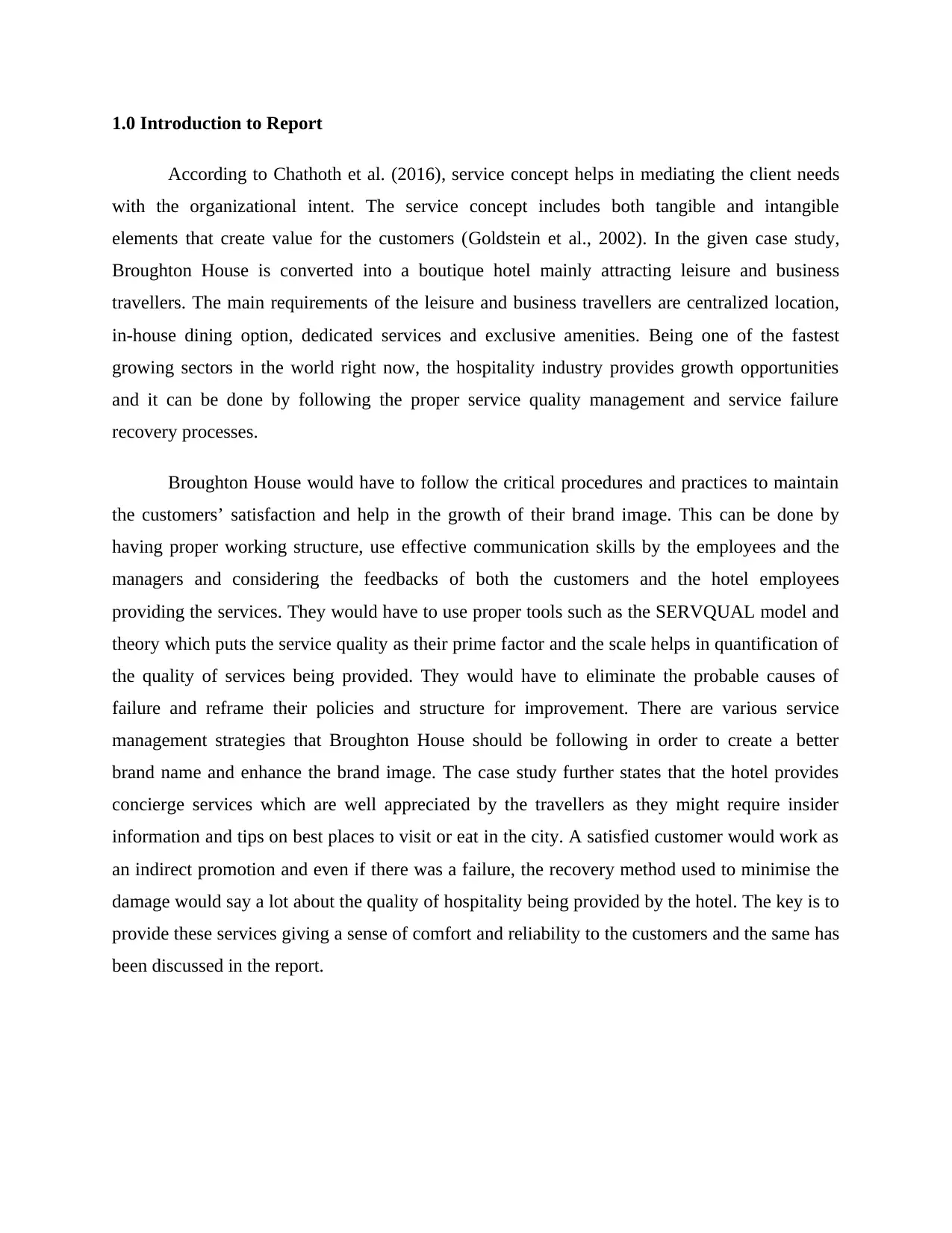
1.0 Introduction to Report
According to Chathoth et al. (2016), service concept helps in mediating the client needs
with the organizational intent. The service concept includes both tangible and intangible
elements that create value for the customers (Goldstein et al., 2002). In the given case study,
Broughton House is converted into a boutique hotel mainly attracting leisure and business
travellers. The main requirements of the leisure and business travellers are centralized location,
in-house dining option, dedicated services and exclusive amenities. Being one of the fastest
growing sectors in the world right now, the hospitality industry provides growth opportunities
and it can be done by following the proper service quality management and service failure
recovery processes.
Broughton House would have to follow the critical procedures and practices to maintain
the customers’ satisfaction and help in the growth of their brand image. This can be done by
having proper working structure, use effective communication skills by the employees and the
managers and considering the feedbacks of both the customers and the hotel employees
providing the services. They would have to use proper tools such as the SERVQUAL model and
theory which puts the service quality as their prime factor and the scale helps in quantification of
the quality of services being provided. They would have to eliminate the probable causes of
failure and reframe their policies and structure for improvement. There are various service
management strategies that Broughton House should be following in order to create a better
brand name and enhance the brand image. The case study further states that the hotel provides
concierge services which are well appreciated by the travellers as they might require insider
information and tips on best places to visit or eat in the city. A satisfied customer would work as
an indirect promotion and even if there was a failure, the recovery method used to minimise the
damage would say a lot about the quality of hospitality being provided by the hotel. The key is to
provide these services giving a sense of comfort and reliability to the customers and the same has
been discussed in the report.
According to Chathoth et al. (2016), service concept helps in mediating the client needs
with the organizational intent. The service concept includes both tangible and intangible
elements that create value for the customers (Goldstein et al., 2002). In the given case study,
Broughton House is converted into a boutique hotel mainly attracting leisure and business
travellers. The main requirements of the leisure and business travellers are centralized location,
in-house dining option, dedicated services and exclusive amenities. Being one of the fastest
growing sectors in the world right now, the hospitality industry provides growth opportunities
and it can be done by following the proper service quality management and service failure
recovery processes.
Broughton House would have to follow the critical procedures and practices to maintain
the customers’ satisfaction and help in the growth of their brand image. This can be done by
having proper working structure, use effective communication skills by the employees and the
managers and considering the feedbacks of both the customers and the hotel employees
providing the services. They would have to use proper tools such as the SERVQUAL model and
theory which puts the service quality as their prime factor and the scale helps in quantification of
the quality of services being provided. They would have to eliminate the probable causes of
failure and reframe their policies and structure for improvement. There are various service
management strategies that Broughton House should be following in order to create a better
brand name and enhance the brand image. The case study further states that the hotel provides
concierge services which are well appreciated by the travellers as they might require insider
information and tips on best places to visit or eat in the city. A satisfied customer would work as
an indirect promotion and even if there was a failure, the recovery method used to minimise the
damage would say a lot about the quality of hospitality being provided by the hotel. The key is to
provide these services giving a sense of comfort and reliability to the customers and the same has
been discussed in the report.
Paraphrase This Document
Need a fresh take? Get an instant paraphrase of this document with our AI Paraphraser
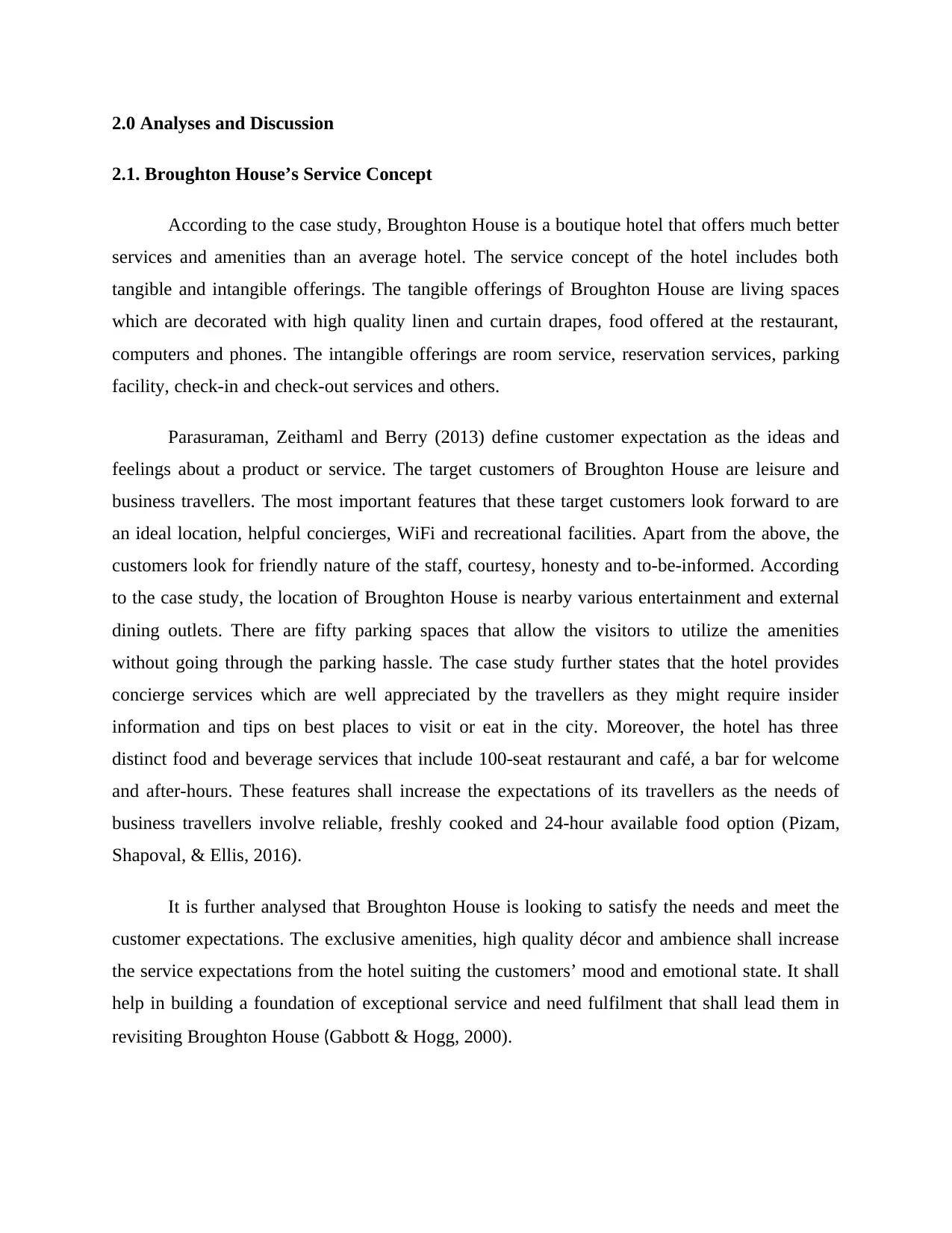
2.0 Analyses and Discussion
2.1. Broughton House’s Service Concept
According to the case study, Broughton House is a boutique hotel that offers much better
services and amenities than an average hotel. The service concept of the hotel includes both
tangible and intangible offerings. The tangible offerings of Broughton House are living spaces
which are decorated with high quality linen and curtain drapes, food offered at the restaurant,
computers and phones. The intangible offerings are room service, reservation services, parking
facility, check-in and check-out services and others.
Parasuraman, Zeithaml and Berry (2013) define customer expectation as the ideas and
feelings about a product or service. The target customers of Broughton House are leisure and
business travellers. The most important features that these target customers look forward to are
an ideal location, helpful concierges, WiFi and recreational facilities. Apart from the above, the
customers look for friendly nature of the staff, courtesy, honesty and to-be-informed. According
to the case study, the location of Broughton House is nearby various entertainment and external
dining outlets. There are fifty parking spaces that allow the visitors to utilize the amenities
without going through the parking hassle. The case study further states that the hotel provides
concierge services which are well appreciated by the travellers as they might require insider
information and tips on best places to visit or eat in the city. Moreover, the hotel has three
distinct food and beverage services that include 100-seat restaurant and café, a bar for welcome
and after-hours. These features shall increase the expectations of its travellers as the needs of
business travellers involve reliable, freshly cooked and 24-hour available food option (Pizam,
Shapoval, & Ellis, 2016).
It is further analysed that Broughton House is looking to satisfy the needs and meet the
customer expectations. The exclusive amenities, high quality décor and ambience shall increase
the service expectations from the hotel suiting the customers’ mood and emotional state. It shall
help in building a foundation of exceptional service and need fulfilment that shall lead them in
revisiting Broughton House (Gabbott & Hogg, 2000).
2.1. Broughton House’s Service Concept
According to the case study, Broughton House is a boutique hotel that offers much better
services and amenities than an average hotel. The service concept of the hotel includes both
tangible and intangible offerings. The tangible offerings of Broughton House are living spaces
which are decorated with high quality linen and curtain drapes, food offered at the restaurant,
computers and phones. The intangible offerings are room service, reservation services, parking
facility, check-in and check-out services and others.
Parasuraman, Zeithaml and Berry (2013) define customer expectation as the ideas and
feelings about a product or service. The target customers of Broughton House are leisure and
business travellers. The most important features that these target customers look forward to are
an ideal location, helpful concierges, WiFi and recreational facilities. Apart from the above, the
customers look for friendly nature of the staff, courtesy, honesty and to-be-informed. According
to the case study, the location of Broughton House is nearby various entertainment and external
dining outlets. There are fifty parking spaces that allow the visitors to utilize the amenities
without going through the parking hassle. The case study further states that the hotel provides
concierge services which are well appreciated by the travellers as they might require insider
information and tips on best places to visit or eat in the city. Moreover, the hotel has three
distinct food and beverage services that include 100-seat restaurant and café, a bar for welcome
and after-hours. These features shall increase the expectations of its travellers as the needs of
business travellers involve reliable, freshly cooked and 24-hour available food option (Pizam,
Shapoval, & Ellis, 2016).
It is further analysed that Broughton House is looking to satisfy the needs and meet the
customer expectations. The exclusive amenities, high quality décor and ambience shall increase
the service expectations from the hotel suiting the customers’ mood and emotional state. It shall
help in building a foundation of exceptional service and need fulfilment that shall lead them in
revisiting Broughton House (Gabbott & Hogg, 2000).
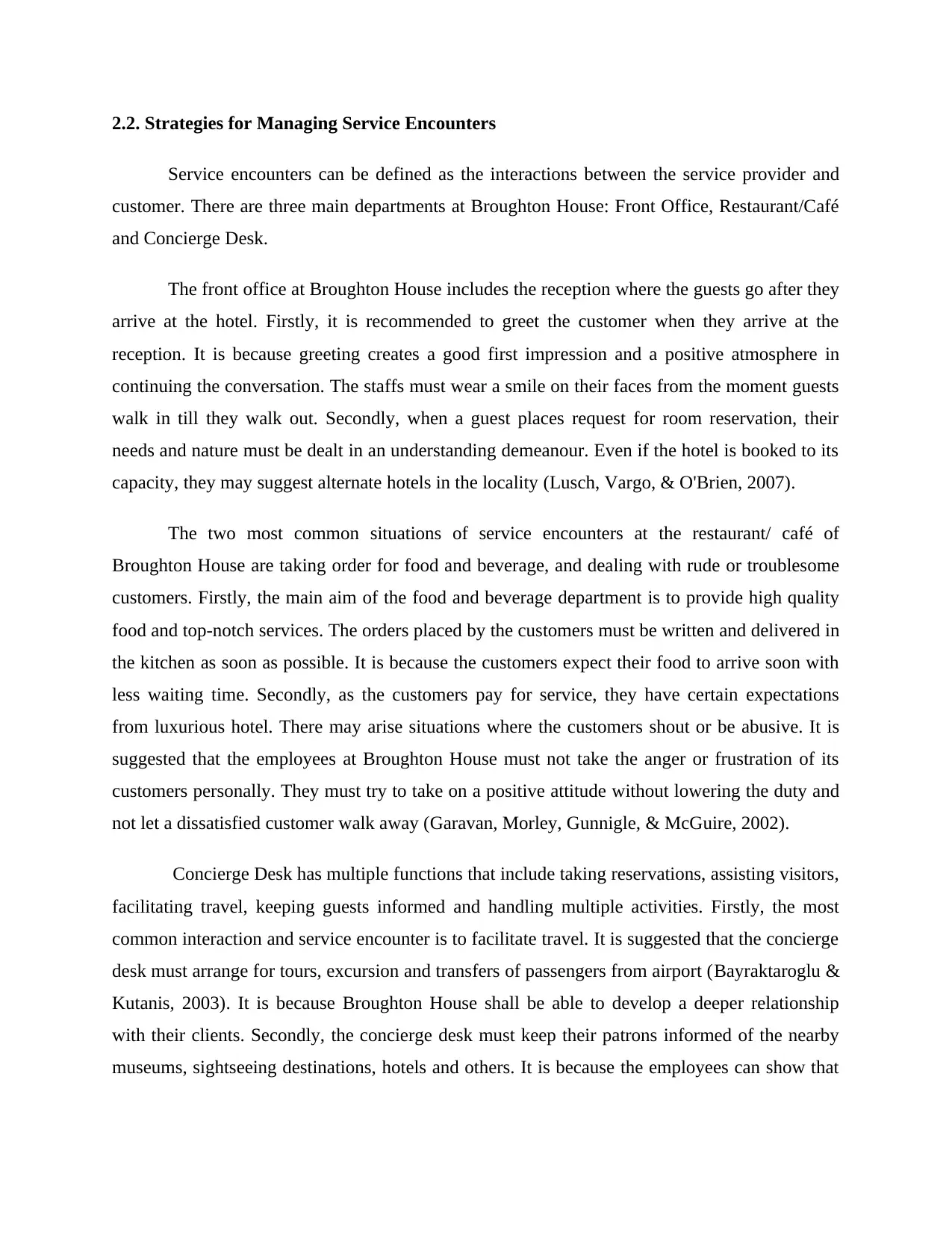
2.2. Strategies for Managing Service Encounters
Service encounters can be defined as the interactions between the service provider and
customer. There are three main departments at Broughton House: Front Office, Restaurant/Café
and Concierge Desk.
The front office at Broughton House includes the reception where the guests go after they
arrive at the hotel. Firstly, it is recommended to greet the customer when they arrive at the
reception. It is because greeting creates a good first impression and a positive atmosphere in
continuing the conversation. The staffs must wear a smile on their faces from the moment guests
walk in till they walk out. Secondly, when a guest places request for room reservation, their
needs and nature must be dealt in an understanding demeanour. Even if the hotel is booked to its
capacity, they may suggest alternate hotels in the locality (Lusch, Vargo, & O'Brien, 2007).
The two most common situations of service encounters at the restaurant/ café of
Broughton House are taking order for food and beverage, and dealing with rude or troublesome
customers. Firstly, the main aim of the food and beverage department is to provide high quality
food and top-notch services. The orders placed by the customers must be written and delivered in
the kitchen as soon as possible. It is because the customers expect their food to arrive soon with
less waiting time. Secondly, as the customers pay for service, they have certain expectations
from luxurious hotel. There may arise situations where the customers shout or be abusive. It is
suggested that the employees at Broughton House must not take the anger or frustration of its
customers personally. They must try to take on a positive attitude without lowering the duty and
not let a dissatisfied customer walk away (Garavan, Morley, Gunnigle, & McGuire, 2002).
Concierge Desk has multiple functions that include taking reservations, assisting visitors,
facilitating travel, keeping guests informed and handling multiple activities. Firstly, the most
common interaction and service encounter is to facilitate travel. It is suggested that the concierge
desk must arrange for tours, excursion and transfers of passengers from airport (Bayraktaroglu &
Kutanis, 2003). It is because Broughton House shall be able to develop a deeper relationship
with their clients. Secondly, the concierge desk must keep their patrons informed of the nearby
museums, sightseeing destinations, hotels and others. It is because the employees can show that
Service encounters can be defined as the interactions between the service provider and
customer. There are three main departments at Broughton House: Front Office, Restaurant/Café
and Concierge Desk.
The front office at Broughton House includes the reception where the guests go after they
arrive at the hotel. Firstly, it is recommended to greet the customer when they arrive at the
reception. It is because greeting creates a good first impression and a positive atmosphere in
continuing the conversation. The staffs must wear a smile on their faces from the moment guests
walk in till they walk out. Secondly, when a guest places request for room reservation, their
needs and nature must be dealt in an understanding demeanour. Even if the hotel is booked to its
capacity, they may suggest alternate hotels in the locality (Lusch, Vargo, & O'Brien, 2007).
The two most common situations of service encounters at the restaurant/ café of
Broughton House are taking order for food and beverage, and dealing with rude or troublesome
customers. Firstly, the main aim of the food and beverage department is to provide high quality
food and top-notch services. The orders placed by the customers must be written and delivered in
the kitchen as soon as possible. It is because the customers expect their food to arrive soon with
less waiting time. Secondly, as the customers pay for service, they have certain expectations
from luxurious hotel. There may arise situations where the customers shout or be abusive. It is
suggested that the employees at Broughton House must not take the anger or frustration of its
customers personally. They must try to take on a positive attitude without lowering the duty and
not let a dissatisfied customer walk away (Garavan, Morley, Gunnigle, & McGuire, 2002).
Concierge Desk has multiple functions that include taking reservations, assisting visitors,
facilitating travel, keeping guests informed and handling multiple activities. Firstly, the most
common interaction and service encounter is to facilitate travel. It is suggested that the concierge
desk must arrange for tours, excursion and transfers of passengers from airport (Bayraktaroglu &
Kutanis, 2003). It is because Broughton House shall be able to develop a deeper relationship
with their clients. Secondly, the concierge desk must keep their patrons informed of the nearby
museums, sightseeing destinations, hotels and others. It is because the employees can show that
⊘ This is a preview!⊘
Do you want full access?
Subscribe today to unlock all pages.

Trusted by 1+ million students worldwide
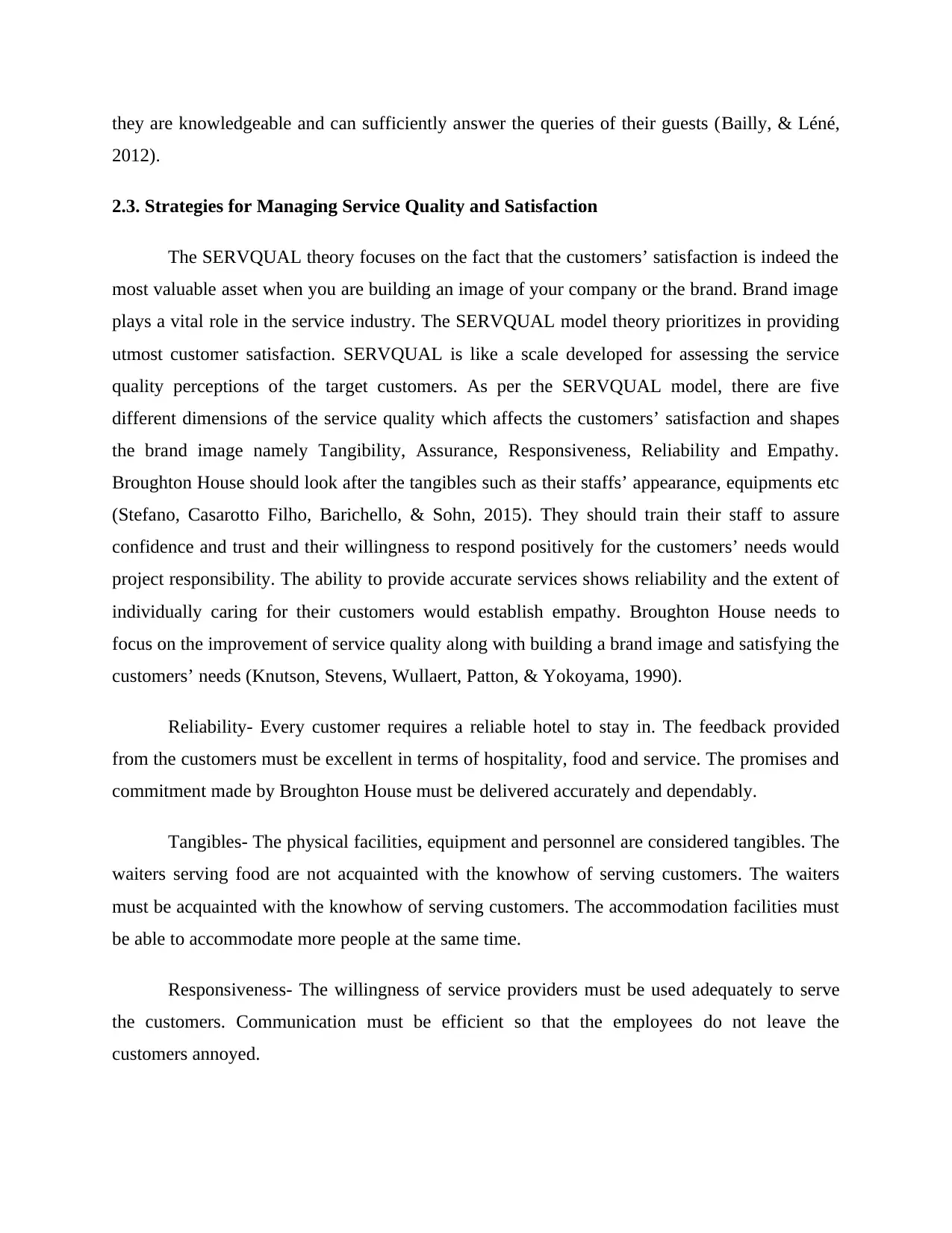
they are knowledgeable and can sufficiently answer the queries of their guests (Bailly, & Léné,
2012).
2.3. Strategies for Managing Service Quality and Satisfaction
The SERVQUAL theory focuses on the fact that the customers’ satisfaction is indeed the
most valuable asset when you are building an image of your company or the brand. Brand image
plays a vital role in the service industry. The SERVQUAL model theory prioritizes in providing
utmost customer satisfaction. SERVQUAL is like a scale developed for assessing the service
quality perceptions of the target customers. As per the SERVQUAL model, there are five
different dimensions of the service quality which affects the customers’ satisfaction and shapes
the brand image namely Tangibility, Assurance, Responsiveness, Reliability and Empathy.
Broughton House should look after the tangibles such as their staffs’ appearance, equipments etc
(Stefano, Casarotto Filho, Barichello, & Sohn, 2015). They should train their staff to assure
confidence and trust and their willingness to respond positively for the customers’ needs would
project responsibility. The ability to provide accurate services shows reliability and the extent of
individually caring for their customers would establish empathy. Broughton House needs to
focus on the improvement of service quality along with building a brand image and satisfying the
customers’ needs (Knutson, Stevens, Wullaert, Patton, & Yokoyama, 1990).
Reliability- Every customer requires a reliable hotel to stay in. The feedback provided
from the customers must be excellent in terms of hospitality, food and service. The promises and
commitment made by Broughton House must be delivered accurately and dependably.
Tangibles- The physical facilities, equipment and personnel are considered tangibles. The
waiters serving food are not acquainted with the knowhow of serving customers. The waiters
must be acquainted with the knowhow of serving customers. The accommodation facilities must
be able to accommodate more people at the same time.
Responsiveness- The willingness of service providers must be used adequately to serve
the customers. Communication must be efficient so that the employees do not leave the
customers annoyed.
2012).
2.3. Strategies for Managing Service Quality and Satisfaction
The SERVQUAL theory focuses on the fact that the customers’ satisfaction is indeed the
most valuable asset when you are building an image of your company or the brand. Brand image
plays a vital role in the service industry. The SERVQUAL model theory prioritizes in providing
utmost customer satisfaction. SERVQUAL is like a scale developed for assessing the service
quality perceptions of the target customers. As per the SERVQUAL model, there are five
different dimensions of the service quality which affects the customers’ satisfaction and shapes
the brand image namely Tangibility, Assurance, Responsiveness, Reliability and Empathy.
Broughton House should look after the tangibles such as their staffs’ appearance, equipments etc
(Stefano, Casarotto Filho, Barichello, & Sohn, 2015). They should train their staff to assure
confidence and trust and their willingness to respond positively for the customers’ needs would
project responsibility. The ability to provide accurate services shows reliability and the extent of
individually caring for their customers would establish empathy. Broughton House needs to
focus on the improvement of service quality along with building a brand image and satisfying the
customers’ needs (Knutson, Stevens, Wullaert, Patton, & Yokoyama, 1990).
Reliability- Every customer requires a reliable hotel to stay in. The feedback provided
from the customers must be excellent in terms of hospitality, food and service. The promises and
commitment made by Broughton House must be delivered accurately and dependably.
Tangibles- The physical facilities, equipment and personnel are considered tangibles. The
waiters serving food are not acquainted with the knowhow of serving customers. The waiters
must be acquainted with the knowhow of serving customers. The accommodation facilities must
be able to accommodate more people at the same time.
Responsiveness- The willingness of service providers must be used adequately to serve
the customers. Communication must be efficient so that the employees do not leave the
customers annoyed.
Paraphrase This Document
Need a fresh take? Get an instant paraphrase of this document with our AI Paraphraser
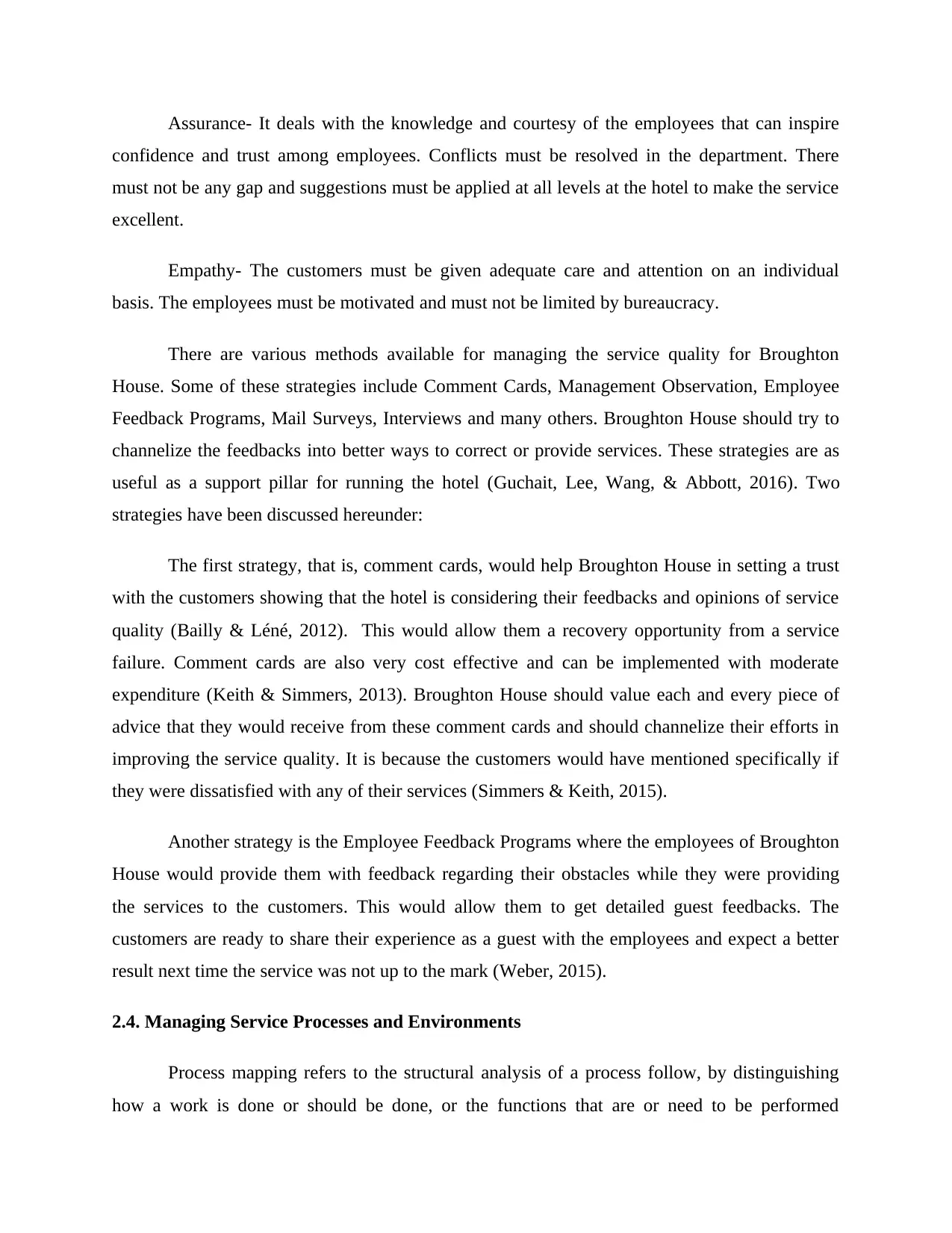
Assurance- It deals with the knowledge and courtesy of the employees that can inspire
confidence and trust among employees. Conflicts must be resolved in the department. There
must not be any gap and suggestions must be applied at all levels at the hotel to make the service
excellent.
Empathy- The customers must be given adequate care and attention on an individual
basis. The employees must be motivated and must not be limited by bureaucracy.
There are various methods available for managing the service quality for Broughton
House. Some of these strategies include Comment Cards, Management Observation, Employee
Feedback Programs, Mail Surveys, Interviews and many others. Broughton House should try to
channelize the feedbacks into better ways to correct or provide services. These strategies are as
useful as a support pillar for running the hotel (Guchait, Lee, Wang, & Abbott, 2016). Two
strategies have been discussed hereunder:
The first strategy, that is, comment cards, would help Broughton House in setting a trust
with the customers showing that the hotel is considering their feedbacks and opinions of service
quality (Bailly & Léné, 2012). This would allow them a recovery opportunity from a service
failure. Comment cards are also very cost effective and can be implemented with moderate
expenditure (Keith & Simmers, 2013). Broughton House should value each and every piece of
advice that they would receive from these comment cards and should channelize their efforts in
improving the service quality. It is because the customers would have mentioned specifically if
they were dissatisfied with any of their services (Simmers & Keith, 2015).
Another strategy is the Employee Feedback Programs where the employees of Broughton
House would provide them with feedback regarding their obstacles while they were providing
the services to the customers. This would allow them to get detailed guest feedbacks. The
customers are ready to share their experience as a guest with the employees and expect a better
result next time the service was not up to the mark (Weber, 2015).
2.4. Managing Service Processes and Environments
Process mapping refers to the structural analysis of a process follow, by distinguishing
how a work is done or should be done, or the functions that are or need to be performed
confidence and trust among employees. Conflicts must be resolved in the department. There
must not be any gap and suggestions must be applied at all levels at the hotel to make the service
excellent.
Empathy- The customers must be given adequate care and attention on an individual
basis. The employees must be motivated and must not be limited by bureaucracy.
There are various methods available for managing the service quality for Broughton
House. Some of these strategies include Comment Cards, Management Observation, Employee
Feedback Programs, Mail Surveys, Interviews and many others. Broughton House should try to
channelize the feedbacks into better ways to correct or provide services. These strategies are as
useful as a support pillar for running the hotel (Guchait, Lee, Wang, & Abbott, 2016). Two
strategies have been discussed hereunder:
The first strategy, that is, comment cards, would help Broughton House in setting a trust
with the customers showing that the hotel is considering their feedbacks and opinions of service
quality (Bailly & Léné, 2012). This would allow them a recovery opportunity from a service
failure. Comment cards are also very cost effective and can be implemented with moderate
expenditure (Keith & Simmers, 2013). Broughton House should value each and every piece of
advice that they would receive from these comment cards and should channelize their efforts in
improving the service quality. It is because the customers would have mentioned specifically if
they were dissatisfied with any of their services (Simmers & Keith, 2015).
Another strategy is the Employee Feedback Programs where the employees of Broughton
House would provide them with feedback regarding their obstacles while they were providing
the services to the customers. This would allow them to get detailed guest feedbacks. The
customers are ready to share their experience as a guest with the employees and expect a better
result next time the service was not up to the mark (Weber, 2015).
2.4. Managing Service Processes and Environments
Process mapping refers to the structural analysis of a process follow, by distinguishing
how a work is done or should be done, or the functions that are or need to be performed
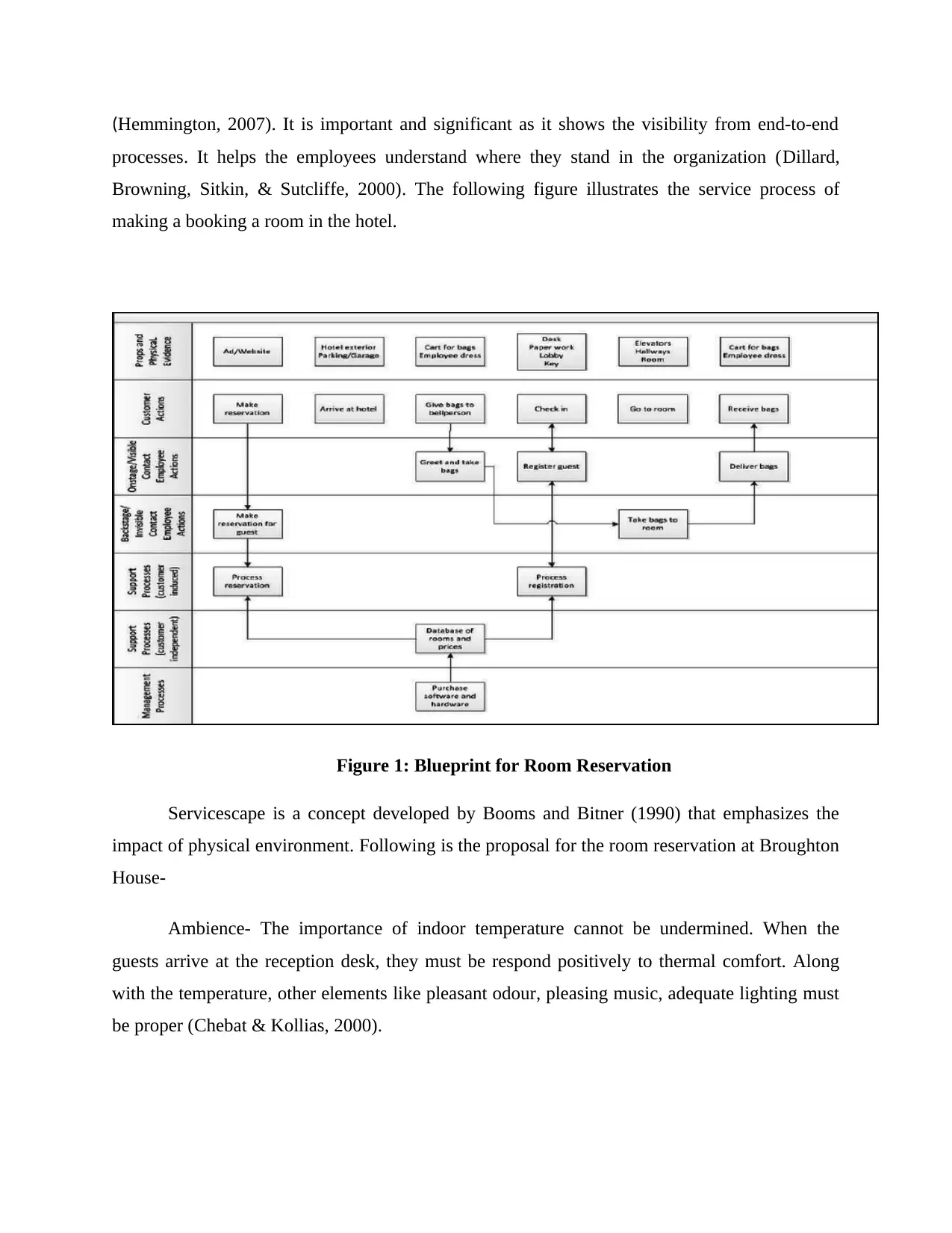
(Hemmington, 2007). It is important and significant as it shows the visibility from end-to-end
processes. It helps the employees understand where they stand in the organization (Dillard,
Browning, Sitkin, & Sutcliffe, 2000). The following figure illustrates the service process of
making a booking a room in the hotel.
Figure 1: Blueprint for Room Reservation
Servicescape is a concept developed by Booms and Bitner (1990) that emphasizes the
impact of physical environment. Following is the proposal for the room reservation at Broughton
House-
Ambience- The importance of indoor temperature cannot be undermined. When the
guests arrive at the reception desk, they must be respond positively to thermal comfort. Along
with the temperature, other elements like pleasant odour, pleasing music, adequate lighting must
be proper (Chebat & Kollias, 2000).
processes. It helps the employees understand where they stand in the organization (Dillard,
Browning, Sitkin, & Sutcliffe, 2000). The following figure illustrates the service process of
making a booking a room in the hotel.
Figure 1: Blueprint for Room Reservation
Servicescape is a concept developed by Booms and Bitner (1990) that emphasizes the
impact of physical environment. Following is the proposal for the room reservation at Broughton
House-
Ambience- The importance of indoor temperature cannot be undermined. When the
guests arrive at the reception desk, they must be respond positively to thermal comfort. Along
with the temperature, other elements like pleasant odour, pleasing music, adequate lighting must
be proper (Chebat & Kollias, 2000).
⊘ This is a preview!⊘
Do you want full access?
Subscribe today to unlock all pages.

Trusted by 1+ million students worldwide
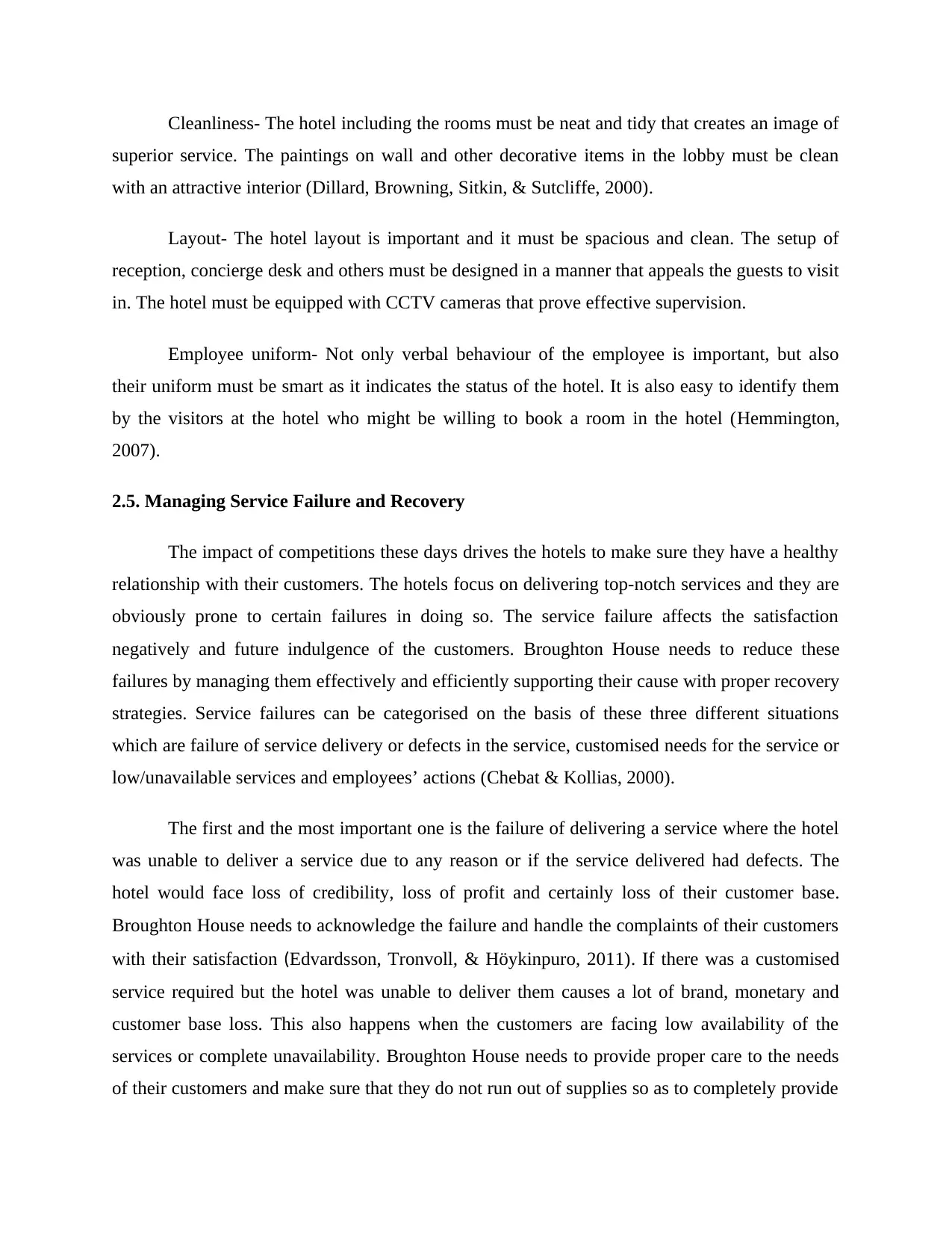
Cleanliness- The hotel including the rooms must be neat and tidy that creates an image of
superior service. The paintings on wall and other decorative items in the lobby must be clean
with an attractive interior (Dillard, Browning, Sitkin, & Sutcliffe, 2000).
Layout- The hotel layout is important and it must be spacious and clean. The setup of
reception, concierge desk and others must be designed in a manner that appeals the guests to visit
in. The hotel must be equipped with CCTV cameras that prove effective supervision.
Employee uniform- Not only verbal behaviour of the employee is important, but also
their uniform must be smart as it indicates the status of the hotel. It is also easy to identify them
by the visitors at the hotel who might be willing to book a room in the hotel (Hemmington,
2007).
2.5. Managing Service Failure and Recovery
The impact of competitions these days drives the hotels to make sure they have a healthy
relationship with their customers. The hotels focus on delivering top-notch services and they are
obviously prone to certain failures in doing so. The service failure affects the satisfaction
negatively and future indulgence of the customers. Broughton House needs to reduce these
failures by managing them effectively and efficiently supporting their cause with proper recovery
strategies. Service failures can be categorised on the basis of these three different situations
which are failure of service delivery or defects in the service, customised needs for the service or
low/unavailable services and employees’ actions (Chebat & Kollias, 2000).
The first and the most important one is the failure of delivering a service where the hotel
was unable to deliver a service due to any reason or if the service delivered had defects. The
hotel would face loss of credibility, loss of profit and certainly loss of their customer base.
Broughton House needs to acknowledge the failure and handle the complaints of their customers
with their satisfaction (Edvardsson, Tronvoll, & Höykinpuro, 2011). If there was a customised
service required but the hotel was unable to deliver them causes a lot of brand, monetary and
customer base loss. This also happens when the customers are facing low availability of the
services or complete unavailability. Broughton House needs to provide proper care to the needs
of their customers and make sure that they do not run out of supplies so as to completely provide
superior service. The paintings on wall and other decorative items in the lobby must be clean
with an attractive interior (Dillard, Browning, Sitkin, & Sutcliffe, 2000).
Layout- The hotel layout is important and it must be spacious and clean. The setup of
reception, concierge desk and others must be designed in a manner that appeals the guests to visit
in. The hotel must be equipped with CCTV cameras that prove effective supervision.
Employee uniform- Not only verbal behaviour of the employee is important, but also
their uniform must be smart as it indicates the status of the hotel. It is also easy to identify them
by the visitors at the hotel who might be willing to book a room in the hotel (Hemmington,
2007).
2.5. Managing Service Failure and Recovery
The impact of competitions these days drives the hotels to make sure they have a healthy
relationship with their customers. The hotels focus on delivering top-notch services and they are
obviously prone to certain failures in doing so. The service failure affects the satisfaction
negatively and future indulgence of the customers. Broughton House needs to reduce these
failures by managing them effectively and efficiently supporting their cause with proper recovery
strategies. Service failures can be categorised on the basis of these three different situations
which are failure of service delivery or defects in the service, customised needs for the service or
low/unavailable services and employees’ actions (Chebat & Kollias, 2000).
The first and the most important one is the failure of delivering a service where the hotel
was unable to deliver a service due to any reason or if the service delivered had defects. The
hotel would face loss of credibility, loss of profit and certainly loss of their customer base.
Broughton House needs to acknowledge the failure and handle the complaints of their customers
with their satisfaction (Edvardsson, Tronvoll, & Höykinpuro, 2011). If there was a customised
service required but the hotel was unable to deliver them causes a lot of brand, monetary and
customer base loss. This also happens when the customers are facing low availability of the
services or complete unavailability. Broughton House needs to provide proper care to the needs
of their customers and make sure that they do not run out of supplies so as to completely provide
Paraphrase This Document
Need a fresh take? Get an instant paraphrase of this document with our AI Paraphraser
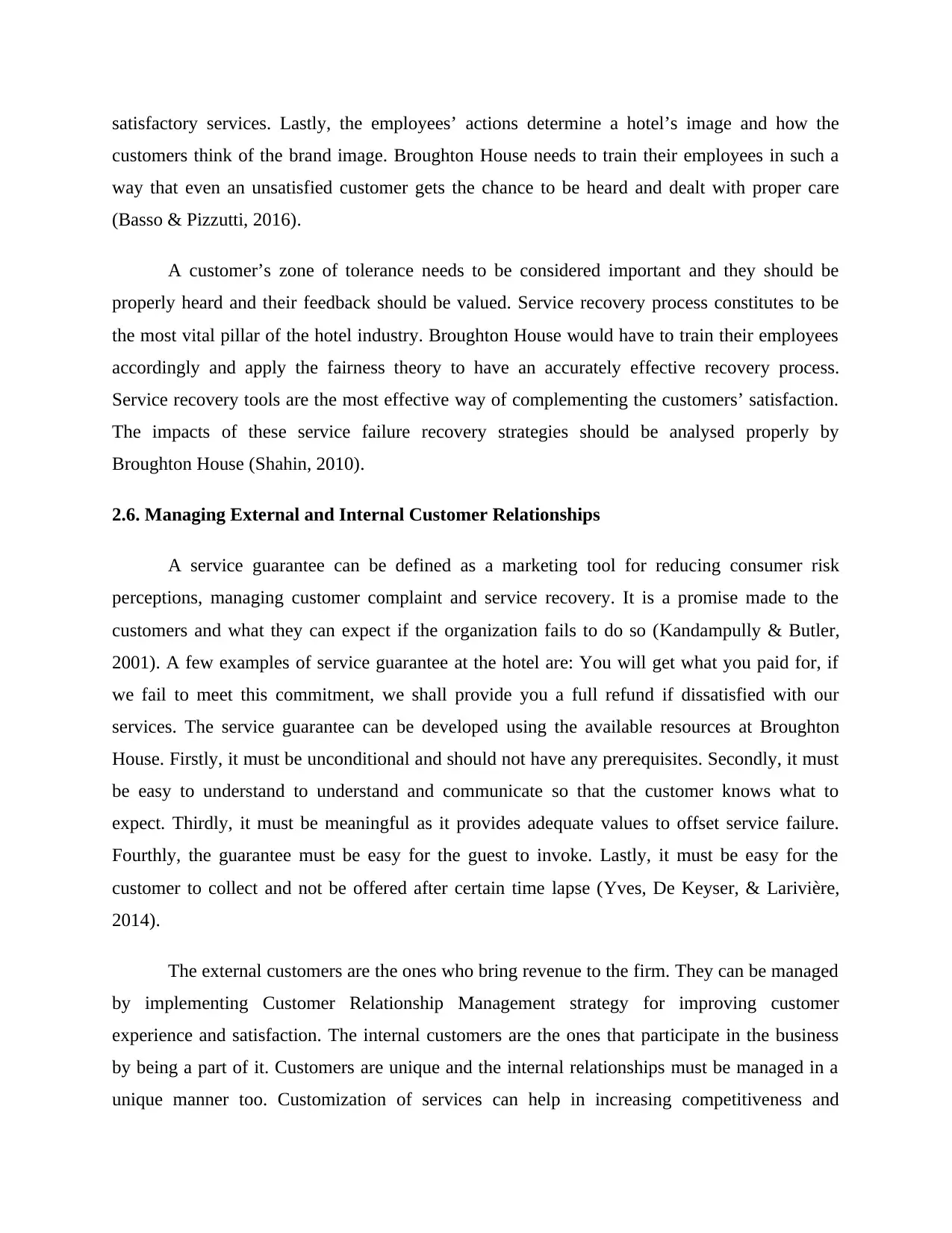
satisfactory services. Lastly, the employees’ actions determine a hotel’s image and how the
customers think of the brand image. Broughton House needs to train their employees in such a
way that even an unsatisfied customer gets the chance to be heard and dealt with proper care
(Basso & Pizzutti, 2016).
A customer’s zone of tolerance needs to be considered important and they should be
properly heard and their feedback should be valued. Service recovery process constitutes to be
the most vital pillar of the hotel industry. Broughton House would have to train their employees
accordingly and apply the fairness theory to have an accurately effective recovery process.
Service recovery tools are the most effective way of complementing the customers’ satisfaction.
The impacts of these service failure recovery strategies should be analysed properly by
Broughton House (Shahin, 2010).
2.6. Managing External and Internal Customer Relationships
A service guarantee can be defined as a marketing tool for reducing consumer risk
perceptions, managing customer complaint and service recovery. It is a promise made to the
customers and what they can expect if the organization fails to do so (Kandampully & Butler,
2001). A few examples of service guarantee at the hotel are: You will get what you paid for, if
we fail to meet this commitment, we shall provide you a full refund if dissatisfied with our
services. The service guarantee can be developed using the available resources at Broughton
House. Firstly, it must be unconditional and should not have any prerequisites. Secondly, it must
be easy to understand to understand and communicate so that the customer knows what to
expect. Thirdly, it must be meaningful as it provides adequate values to offset service failure.
Fourthly, the guarantee must be easy for the guest to invoke. Lastly, it must be easy for the
customer to collect and not be offered after certain time lapse (Yves, De Keyser, & Larivière,
2014).
The external customers are the ones who bring revenue to the firm. They can be managed
by implementing Customer Relationship Management strategy for improving customer
experience and satisfaction. The internal customers are the ones that participate in the business
by being a part of it. Customers are unique and the internal relationships must be managed in a
unique manner too. Customization of services can help in increasing competitiveness and
customers think of the brand image. Broughton House needs to train their employees in such a
way that even an unsatisfied customer gets the chance to be heard and dealt with proper care
(Basso & Pizzutti, 2016).
A customer’s zone of tolerance needs to be considered important and they should be
properly heard and their feedback should be valued. Service recovery process constitutes to be
the most vital pillar of the hotel industry. Broughton House would have to train their employees
accordingly and apply the fairness theory to have an accurately effective recovery process.
Service recovery tools are the most effective way of complementing the customers’ satisfaction.
The impacts of these service failure recovery strategies should be analysed properly by
Broughton House (Shahin, 2010).
2.6. Managing External and Internal Customer Relationships
A service guarantee can be defined as a marketing tool for reducing consumer risk
perceptions, managing customer complaint and service recovery. It is a promise made to the
customers and what they can expect if the organization fails to do so (Kandampully & Butler,
2001). A few examples of service guarantee at the hotel are: You will get what you paid for, if
we fail to meet this commitment, we shall provide you a full refund if dissatisfied with our
services. The service guarantee can be developed using the available resources at Broughton
House. Firstly, it must be unconditional and should not have any prerequisites. Secondly, it must
be easy to understand to understand and communicate so that the customer knows what to
expect. Thirdly, it must be meaningful as it provides adequate values to offset service failure.
Fourthly, the guarantee must be easy for the guest to invoke. Lastly, it must be easy for the
customer to collect and not be offered after certain time lapse (Yves, De Keyser, & Larivière,
2014).
The external customers are the ones who bring revenue to the firm. They can be managed
by implementing Customer Relationship Management strategy for improving customer
experience and satisfaction. The internal customers are the ones that participate in the business
by being a part of it. Customers are unique and the internal relationships must be managed in a
unique manner too. Customization of services can help in increasing competitiveness and
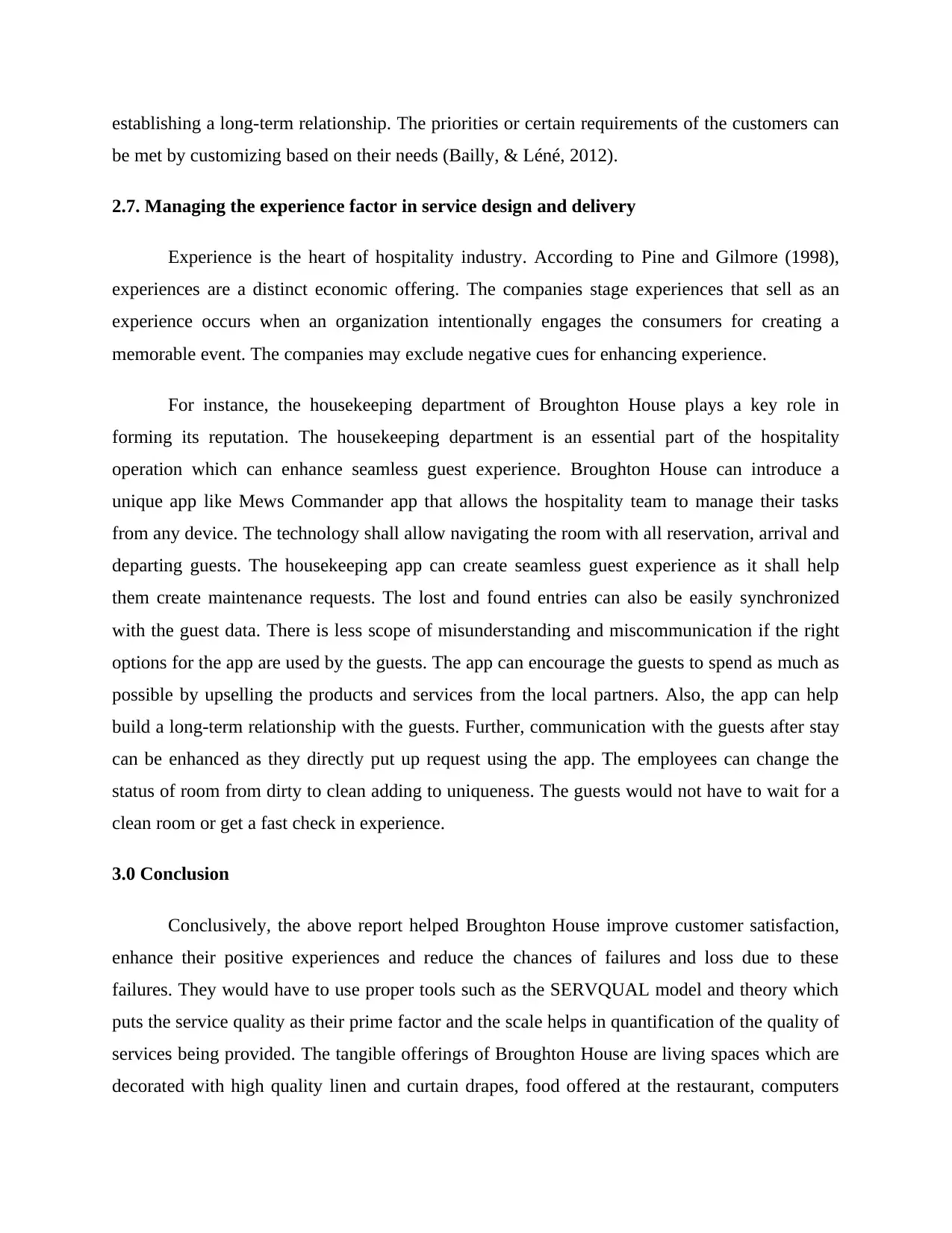
establishing a long-term relationship. The priorities or certain requirements of the customers can
be met by customizing based on their needs (Bailly, & Léné, 2012).
2.7. Managing the experience factor in service design and delivery
Experience is the heart of hospitality industry. According to Pine and Gilmore (1998),
experiences are a distinct economic offering. The companies stage experiences that sell as an
experience occurs when an organization intentionally engages the consumers for creating a
memorable event. The companies may exclude negative cues for enhancing experience.
For instance, the housekeeping department of Broughton House plays a key role in
forming its reputation. The housekeeping department is an essential part of the hospitality
operation which can enhance seamless guest experience. Broughton House can introduce a
unique app like Mews Commander app that allows the hospitality team to manage their tasks
from any device. The technology shall allow navigating the room with all reservation, arrival and
departing guests. The housekeeping app can create seamless guest experience as it shall help
them create maintenance requests. The lost and found entries can also be easily synchronized
with the guest data. There is less scope of misunderstanding and miscommunication if the right
options for the app are used by the guests. The app can encourage the guests to spend as much as
possible by upselling the products and services from the local partners. Also, the app can help
build a long-term relationship with the guests. Further, communication with the guests after stay
can be enhanced as they directly put up request using the app. The employees can change the
status of room from dirty to clean adding to uniqueness. The guests would not have to wait for a
clean room or get a fast check in experience.
3.0 Conclusion
Conclusively, the above report helped Broughton House improve customer satisfaction,
enhance their positive experiences and reduce the chances of failures and loss due to these
failures. They would have to use proper tools such as the SERVQUAL model and theory which
puts the service quality as their prime factor and the scale helps in quantification of the quality of
services being provided. The tangible offerings of Broughton House are living spaces which are
decorated with high quality linen and curtain drapes, food offered at the restaurant, computers
be met by customizing based on their needs (Bailly, & Léné, 2012).
2.7. Managing the experience factor in service design and delivery
Experience is the heart of hospitality industry. According to Pine and Gilmore (1998),
experiences are a distinct economic offering. The companies stage experiences that sell as an
experience occurs when an organization intentionally engages the consumers for creating a
memorable event. The companies may exclude negative cues for enhancing experience.
For instance, the housekeeping department of Broughton House plays a key role in
forming its reputation. The housekeeping department is an essential part of the hospitality
operation which can enhance seamless guest experience. Broughton House can introduce a
unique app like Mews Commander app that allows the hospitality team to manage their tasks
from any device. The technology shall allow navigating the room with all reservation, arrival and
departing guests. The housekeeping app can create seamless guest experience as it shall help
them create maintenance requests. The lost and found entries can also be easily synchronized
with the guest data. There is less scope of misunderstanding and miscommunication if the right
options for the app are used by the guests. The app can encourage the guests to spend as much as
possible by upselling the products and services from the local partners. Also, the app can help
build a long-term relationship with the guests. Further, communication with the guests after stay
can be enhanced as they directly put up request using the app. The employees can change the
status of room from dirty to clean adding to uniqueness. The guests would not have to wait for a
clean room or get a fast check in experience.
3.0 Conclusion
Conclusively, the above report helped Broughton House improve customer satisfaction,
enhance their positive experiences and reduce the chances of failures and loss due to these
failures. They would have to use proper tools such as the SERVQUAL model and theory which
puts the service quality as their prime factor and the scale helps in quantification of the quality of
services being provided. The tangible offerings of Broughton House are living spaces which are
decorated with high quality linen and curtain drapes, food offered at the restaurant, computers
⊘ This is a preview!⊘
Do you want full access?
Subscribe today to unlock all pages.

Trusted by 1+ million students worldwide
1 out of 24
Related Documents
Your All-in-One AI-Powered Toolkit for Academic Success.
+13062052269
info@desklib.com
Available 24*7 on WhatsApp / Email
![[object Object]](/_next/static/media/star-bottom.7253800d.svg)
Unlock your academic potential
Copyright © 2020–2025 A2Z Services. All Rights Reserved. Developed and managed by ZUCOL.





